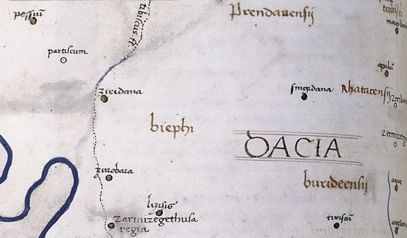|
Biephi
Biephi was a Dacian tribe.Dacia: Landscape, Colonization and Romanization by Ioana A Oltean, , 2007, page 46 See also *List of ancient cities in Thrace and Dacia This is a list of ancient cities, towns, villages, and fortresses in and around Thrace and Dacia. A number of these settlements were Dacian and Thracian, but some were Celtic, Greek, Roman, Paeonian, or Persian. A number of cities in Dacia ... References External links Ancient tribes in Dacia Dacian tribes {{dacia-stub ... [...More Info...] [...Related Items...] OR: [Wikipedia] [Google] [Baidu] |
Dacians
The Dacians (; la, Daci ; grc-gre, Δάκοι, Δάοι, Δάκαι) were the ancient Indo-European inhabitants of the cultural region of Dacia, located in the area near the Carpathian Mountains and west of the Black Sea. They are often considered a subgroup of the Thracians. This area includes mainly the present-day countries of Romania and Moldova, as well as parts of Ukraine, Eastern Serbia, Northern Bulgaria, Slovakia, Hungary and Southern Poland. The Dacians and the related Getae spoke the Dacian language, which has a debated relationship with the neighbouring Thracian language and may be a subgroup of it. Dacians were somewhat culturally influenced by the neighbouring Scythians and by the Celtic invaders of the 4th century BC. Name and etymology Name The Dacians were known as ''Geta'' (plural ''Getae'') in Ancient Greek writings, and as ''Dacus'' (plural ''Daci'') or ''Getae'' in Roman documents, but also as ''Dagae'' and ''Gaete'' as depicted on the late ... [...More Info...] [...Related Items...] OR: [Wikipedia] [Google] [Baidu] |
Ancient Tribes In Dacia
This is a list of ancient tribes in Thrace and Dacia ( grc, Θρᾴκη, Δακία) including possibly or partly Thracian or Dacian tribes, and non-Thracian or non-Dacian tribes that inhabited the lands known as Thrace and Dacia. A great number of Ancient Greek tribes lived in these regions as well, albeit in the Greek colonies. Tribes Thracian Certain tribes and subdivisions of tribes were named differently by ancient writers but modern research points out that these were in fact the same tribe. The name ''Thracians'' itself seems to be a Greek exonym and we have no way of knowing what the Thracians called themselves. Also certain tribes mentioned by Homer are not indeed historical. * Agrianes * Apsynthii * Astae,The Thracians 700 BC-AD 46 (Men-at-Arms) by Christopher Webber and Angus McBride, , 2001, page 11: "After the battle, 10,000 Thracians drawn from the Astii, Caeni, Maduateni and Coreli occupied each side of a narrow forested pass ..." they appear in the 2nd centu ... [...More Info...] [...Related Items...] OR: [Wikipedia] [Google] [Baidu] |
Ptolemy Geographia - Dacia - Central Section
Claudius Ptolemy (; grc-gre, Πτολεμαῖος, ; la, Claudius Ptolemaeus; AD) was a mathematician, astronomer, astrologer, geographer, and music theorist, who wrote about a dozen scientific treatises, three of which were of importance to later Byzantine, Islamic, and Western European science. The first is the astronomical treatise now known as the '' Almagest'', although it was originally entitled the ''Mathēmatikē Syntaxis'' or ''Mathematical Treatise'', and later known as ''The Greatest Treatise''. The second is the ''Geography'', which is a thorough discussion on maps and the geographic knowledge of the Greco-Roman world. The third is the astrological treatise in which he attempted to adapt horoscopic astrology to the Aristotelian natural philosophy of his day. This is sometimes known as the ''Apotelesmatika'' (lit. "On the Effects") but more commonly known as the '' Tetrábiblos'', from the Koine Greek meaning "Four Books", or by its Latin equivalent ''Quadri ... [...More Info...] [...Related Items...] OR: [Wikipedia] [Google] [Baidu] |
Dacia Around 60-44 BC During Burebista, Including Campaigns - French
Dacia (, ; ) was the land inhabited by the Dacians, its core in Transylvania, stretching to the Danube in the south, the Black Sea in the east, and the Tisza in the west. The Carpathian Mountains were located in the middle of Dacia. It thus roughly corresponds to the present-day countries of Romania, as well as parts of Moldova, Bulgaria, Serbia, Hungary, Slovakia, and Ukraine. A Dacian Kingdom of variable size existed between 82 BC until the Roman conquest in AD 106, reaching its height under King Burebista. As a result of the two wars with Emperor Trajan, the population was dispersed and the central city, Sarmizegetusa Regia, was destroyed by the Romans, but was rebuilt by the latter to serve as the capital of the Roman province of Dacia. The Free Dacians, living the territory of modern-day Northern Romania disappeared with the start of the Migration Period. Nomenclature The Dacians are first mentioned in the writings of the Ancient Greeks, in Herodotus (''Histori ... [...More Info...] [...Related Items...] OR: [Wikipedia] [Google] [Baidu] |
List Of Ancient Cities In Thrace And Dacia
This is a list of ancient cities, towns, villages, and fortresses in and around Thrace and Dacia. A number of these settlements were Dacian and Thracian, but some were Celtic, Greek, Roman, Paeonian, or Persian. A number of cities in Dacia and Thrace were built on or close to the sites of preexisting Dacian or Thracian settlements. Some settlements in this list may have a double entry, such as the Paeonian ''Astibo'' and Latin ''Astibus''. It is believed that Thracians did not build true cities even if they were named as such; the largest Thracian settlements were large villages.The Cambridge Ancient History, Volume 3, Part 2: The Assyrian and Babylonian Empires and Other States of the Near East, from the Eighth to the Sixth Centuries BC by John Boardman, I. E. S. Edwards, E. Sollberger, and N. G. L. Hammond ,, 1992, page 612: "Thrace possessed only fortified areas and cities such as Cabassus would have been no more than large villages. In general the population lived in vill ... [...More Info...] [...Related Items...] OR: [Wikipedia] [Google] [Baidu] |





